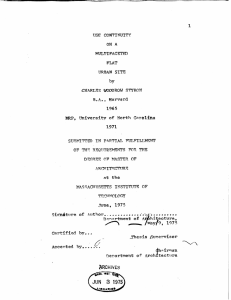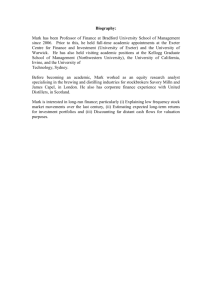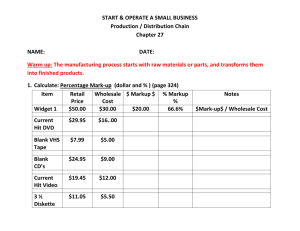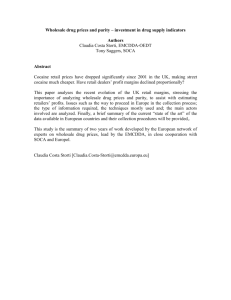ro"
advertisement
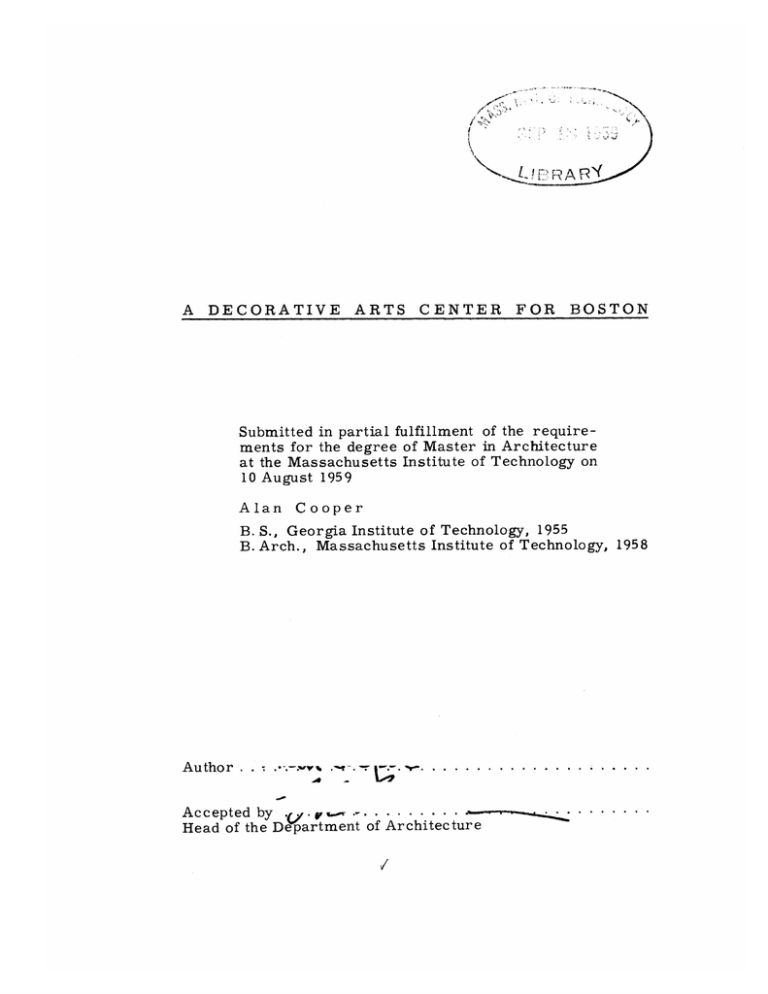
ro" BRAR A DECORATIVE ARTS CENTER FOR BOSTON Submitted in partial fulfillment of the requirements for the degree of Master in Architecture at the Massachusetts Institute of Technology on 10 August 1959 Alan Cooper B. S., Georgia Institute of Technology, 1955 B. Arch., Massachusetts Institute of Technology, 1958 Author Accepted by ...... . - - - - . . Head of the Department of Architecture ...... ABSTRACT This thesis represents an attempt to solve the theoretical problem of designing and siting a large commercial building in Back Bay Boston. The problem was chosen because it offered a program general enough to allow a certain freedom in the evolution of the design and an opportunity to study an uncommon building type--a center for the commercial portion of an industry combining both the retail and wholesale functions of that industry in one building. The body of the work is divided into five parts: 1. The Problem 2. The Program 3. Relation to Environment 4. Architectural Organization 5. Final Drawings. An observation should be made concerning the presentation of the synthesis stage of the fourth part. Here a special effort has been made to isolate some of the factors determining the design. These factors (subheadings) when listed together provide something close to the principles applicable to any large commercial building of this type. The problem of entrances and their positioning is not treated here, however, as the concept of the ground floor is a special case in this particular building. Two initial assumptions concerning the problem are made: 1. The overhang restrictions of the Boston Building Code are relaxed along the Exeter Street and Newbury Street sides of the building. 2. Reinforced concrete is to be the material of construction. 216 Beacon Street Boston, Massachusetts 10 August 1959 Dean Pietro Belluschi School of Architecture and Planning Massachusetts Institute of Technology Cambridge 39, Massachusetts Sir: I have the honor to submit a thesis entitled "A Decorative Arts Center for Boston" as a partial fulfillment of the requirements for the degree of Master in Architecture. Sincerely, Alan Cooper CONTENTS THE PROBLEM....... .............. Report of the G. B. E. S. C. Description of the Site Map page 1 .................... THE PROGRAM. Functional Analysis Diagram page 7 RELATION TO ENVIRONMENT .......... page 10 Diagram ARCHITECTURAL ORGANIZATION ....... page 11 Synthesis Subjective Considerations Method Spatial Organization of Major Units Concept of Ground Floor Placement of Vertical Circulation Service Use of Light Architectural Depth Introduction of a Second Scale Clarification Structure Drawing FINAL DRAWINGS ............ following page 17 7- THE PROBLEM Report of the Greater Boston Economic Study Committee During the past year, wholesalers of high quality home furnishings- -furniture, fabrics, wallpaper, lamps, rugs and other accessories-- considered establishing a decorative arts center in the vicinity of Route 128 to provide the wholesale showroom space they cannot find in the Back Bay area. Reluctantly they decided to abandon the project because the advantages which they derive from a location near the prestige retail area in the Back Bay seemed crucial. Their need for new space and their desire for a central location for the wholesaling of quality home furnishings remains, however. Having surveyed the possibility of relocating out of the downtown, firms in this branch of wholesaling have confirmed their belief that the downtown is the most desirable location for their operations. If incentives are provided for new investment downtown, we believe that a profitable opportunity exists for the construction of a such a decorative arts center in the Back Bay. In contrast to downtown wholesaling in general, the home furnishings sector of the trade has expanded in employment and dollar sales in the last decade. A well defined regional market exists, of which Boston is the focal point and to which interior decorators, buyers from quality retail stores and architects come, often with important clients, to make their selections from the lines of a growing number of manufacturers producing for this market. 1 Wholesalers of quality home furnishings have migrated from the area surrounding North Station to the Back Bay in the last decade because they have found that they profit from being close to the types of prestige retail shops which are the main outlets for their merchandise. Because Boston has become a regional center for the retailing of this type of home furnishing, it is not surprising that wholesalers benefit from being close enough to such stores to permit frequent visits by proprietors with important customers and by retail store buyers from other places in the region who are attracted to the Back Bay area during their frequent 'shopping' trips. To remedy the existing shortage of wholesale display space, firms in the quality home furnishings trade desire a decorative arts center in which they can be housed together to serve a common clientele. Our research indicates that there is a market in such a center for about 168,000 square feet of Of this amount, 75 percent should be devoted to wholesale showroom space, while the remaining portion should provide clearly separated accommodations for prestige retail shops and consumer services serving the same clientele cultivated by the wholesalers of home furnishings. floor space. The design criteria of the center should include air conditioning and unobstructed floor areas designed for maximum flexibility in accommodating the changing display needs of individual tenants. The center also should provide space for two types of activities designed to enhance the consumers' image of the products being displayed and to expose as many possible customers to these products. The center should 2 provide space for some retail stores, and while separated from the wholesale area, it should be designed to encourage easy access to the wholesale displays in order to attract the clientele who patronize quality retail outlets and to interest them in the products displayed. Similarly, the center should have space for an exhibition gallery for temporary exhibits, art shows and displays designed to attract consumers. The Site The site for the proposed building is a portion of a block in the grid pattern of Boston's Back Bay. The block itself is defined (running clockwise from the north) by the lines included between the intersections of four streets: Dartmouth, Boylston, Exeter, and Newbury. The building site is roughly the two-thirds of the block closest to Exeter Street. The remainder of the block is separated into two parts by a service alley. On the Newbury Street side there is a row of ornamented red-brick and stone town houses with shops and art galleries now generally occupying all the first floors. On the Boylston Street side of the alley is the Old South Church, done after the fashion of the Siena Cathedral (Italian Gothic), and dressed in a brownish Roxbury stone. The church has its arcaded tower standing flush with the Boylston Street elevation. Three streets are adjacent to the site: Newbury, Boylston and Exeter. Of these, Boylston is the most important. Running the length of the street on the north side, starting at about Gloucester Street to the west and ending some blocks 3 past the site to the east is a series of five and six story buildings forming a continuous wall. On the south side of Boylston starting at about Hereford or Gloucester Street running to Exeter Street opposite the wall-like buildings is a very large open area over the railroad tracks now of being developed into the Prudential Center- -consisting office buildings, apartment towers, and so forth. Also running from Dartmouth Street east on the south side of Boylston is another, smaller open area--Copley Square (flanked by two of the significant buildings of the American nineteenth century). This leaves the block between Exeter and Dartmouth (the block opposite the building site), a short one block wall of buildings similar to those on the opposite side of the street. A visual narrowing forms between Dartmouth and Exeter (in front of the site) for the heavy pedestrian traffic between the two open areas-Prudential Center and Copley Square. Newbury Street (both sides) to the east of the site is a shopping street of much smaller scale. There are some trees along Newbury opposite the site and the four story town house facades are broken with bays and projecting stairs. The east-west pedestrian traffic is considerable along the street but not equal to the volume of Boylston. The shops of Newbury end, however, just about at the corner of Newbury and Exeter. It is expected that with the coming of the Prudential Center the remainder of Newbury Street running west to Massachusetts Avenue will be developed into shopping similar to that which now exists. 4 Exeter Street across from the site is a minor street compared with the other two. It crosses Boylston and terminates shortly to the south in Huntington Avenue. There are two small shops along Exeter between Newbury and Boylston Streets. 5 000odi to V4 ) THE PROGRAM Functional Analysis The total required area of the building is 168,000 square feet. The functional analysis of this total area was undertaken to accomplish two things: 1. Determine the type, size, and ideal configuration of area needed for each major func tion of the building. 2. Determine the ideal relation between these areas. The type, size (floor area), and configuration of the major spaces needed for the building: Wholesale 120, 000 sq. ft. Deep, unbroken, unobstructed floor area With smaller, more controlled area for customer contact and smaller scale display With office area removed from display area but exercising visual control over it (20, 000 sq. ft.) 40, 000 sq. ft. Retail Deep, unbroken, unobstructed floor area With smaller, more controlled area for displaying items of smaller scale With office area removed from display area (5, 000 sq. ft.) With show window area visually accessible from the street 7 Temporary Exhibition Open, central area With maximum access and visability from street 3, 000 sq. ft. Service and Mechanical Centrally located With access to all vertical supply risers Includes rest rooms, storage, areas for janitors, night watchman, building engineer, and paint and storage shop. 5, 000 sq. ft. The following diagram describes the evolution of relationships between the various parts. It is outlined in six stages as pure system without regard for architectural scale. (Diagram is expressed as section--solid black horizontal represents ground level.) 1. Major Units 2. Service Circulation 3. Pedestrian Circulation 4. Separation of Office Spaces from Major Units 5. Physical Accessibility 6. Visual Accessibility 8 WHOLESALE RETAIL DISPLAY TEMPORARY MECHANICA RELATION TO ENVIRONMENT The building owes a debt to its environment in terms of scale and the quality of materials used on its surface. As outlined in the description of the site, there are two scales with which this building has to contend: the large one of Boylston Street and the smaller one of Newbury. This scale difference, combined with the fact that there is a need for introducing strong north-south pedestrian areas between the linear patterns of Boylston Street and residential Back Bay (Newbury, Commonwealth, Marlborough and Beacon Streets), and the fact that the building site holds the key visual position between the two open areas, Copley Square and the Prudential Center, has led to the particular relation of this building to its surroundings. First, the whole of the site is treated as a raised plaza. (Any mass would interrupt the north-south movement, referring it to Exeter Street and the grid. ) Upon the plaza is placed a high and visually open first level containing the main attraction of the building, the temporary exhibits. The enclosed part of the first level is kept small to allow for the necessary openness in the flow of pedestrian traffic across the site. Secondly, the building as a whole (dotted line in diagram represents overhang) is recessed from the Boylston Street building line to take advantage of the tower of the Old South Church as a vertical element in the composition of the street. Thirdly, the steps up to the plaza are placed with regard to the exterior column line of the building to harmonize with the different scales of the two streets by their definiton of column height and by their definition of sidewalk width. 10 I 2 -S I U ARCHITECTURAL ORGANIZATION Synthe sis Subjective Considerations The subjective considerations (or non-architectural analyses) determine what is to be the character of the building. The subjective considerations in the case of the Decorative Arts Center (as in the case of any building not housing a completely new function) are rooted in history. The history of the nineteenth century is rife with good examples illustrating the development of the urban, commercial palace--the best of these being found in France and America. Two examples of build- ings set within a city pattern were chosen for study--Carson, Pirie, Scott, and Magasin au Bon Marche--to obtain at least an indication of the character necessary in supporting them as totalities of architectural life. It was determined that the large scale of these examples was commensurate with their function--a grand hall of commerce--but that Bon Marche was a stronger solution (from the interior) because of the hollowing out of its interior space giving a center (or centers, in this case) of pedestrian activity. Further (and now in the case of the American Decorative Arts Center) it is desired that an openness and ease of approach be connected with this pedestrian activity and that the general impression derived from the finished building be invitation, order and nobility. 11 Method The major units (wholesale, retail, and temporary display) and minor units (vertical circulation) are now used to effect three things: 1. Create the desired life of the building (major units) 2. Order this life through heirarchy into a totality 3. Enrich and refine the totality (minor units). Spatial Organization of Major Functional Units The major functional units are disposed around a central, unifying architectural element--a lighted court. The lower level (street level) is given over entirely to the temporary display area. Above this, closely connected, on the next level, is the retail area. Above this, on the next four levels, are the wholesale areas. A mezzanine at half level in each of the wholesale spaces contains the wholesale offices. A patterned skylight covers the central court. Concept of the Ground Floor The ground floor is designed to hold the temporary exhibit, provide the means of vertical transportation to the floors above and be the principal element on the plaza site. Its main visual interest (other than the exhibit itself) is the dual spatial experience of being up several feet from street level under a high, defined, regularly articulated and skylighted volume looking out in every direction (except west) to the broken and varied (in scale and color) visual confines of the surrounding buildings and squares under the natural light. 12 Placement of Vertical Circulation The major units of vertical circulation (escalators and passenger elevators) and the minor units of vertical circulation (fire stairs, service elevators, and pipe and duct chases) are placed in the building with regard for their individual functions and their effect on the spaces of the building. The passenger elevators, fire stairs, chases, and service elevators are grouped in four identical units (the passenger elevators taking one whole unit) and are placed through the floors to occur at the corners of the open court on the upper levels and at the corners of the temporary exhibit level on the ground level, extending through to the service and mechanical areas below. The four units extend outward from the corners of the court and the enclosed ground floor exhibit area in the fashion of the blades of a windmill. This allows the fire stairs to exit directly out-of-doors and the units turning outward in this manner begin to define areas (on the ground level) of the plaza for the approaching pedestrian by providing each entrance with a solid element at right angles to it that passes through the glass line. From the inside (on ground level) the units are seen from varying angles and aid in enriching the view out from under the building by blocking out successive portions of it. The circulation from the ground level to the retail level is by escalators placed under the skylight in the main volume. This connects the two levels closely and provides the necessary element for the convergence and movement of people to and from the retail circulation pattern above. 13 Service The service area (along with the mechanical area) is placed under the building and provides truck access to the necessary service elevator points. Truck access from the outside is by way of a ramp from Exeter Street between two of the vertical circulation units. The openings of the service elevators are placed in the temporary display area to easily receive the display racks for moving them below to the paint and repair shop or storage. Use of Light Light (natural and artificial) is used to create the sensation of architectural transparency. On the exterior surfaces, portions of the building are glazed--including all of the wholesale levels -- without apparent connection to the termination of the interior floors and mezzanines. These parts are seen through the glass facade as complete units of another material. At night, with lighting from the interior, the building will appear to be unglazed in these parts, revealing the strong horizontals of the floors. Conversely, under some lighting conditions the glazing will appear opaque and the building will present a series of solids. The skylighting of the central court has been mentioned; it allows a filtered sunlight to fall on the projecting floor terminations, the temporary display area and metallic escalator in the central volume. The artificial lighting of the displays is to be accomplished by placing the necessary adjustable lamps in the suspended ceiling along with the mechanical ductwork. 14 Architectural Depth Almost contrary to the lighting of the building is the effort to achieve depth and deep shadows at certain important The horizontal division between the wholesale and retail areas is recessed sharply from the surface. A strong horizontal rings the building here and gives the divisions. form a diagrammatic appearance when seen from a distance. Introduction of a Second Scale The primary scale of the building is necessarily large. There are elements that enrich this scale--meaning that there are elements that bring the scale down gracefully without destroying its original power. Details, stairways, entrances, furniture, and so forth are the means of doing this. But a conscious introduction of a second, smaller scale of elements just above eye level in the main space at ground level is warranted. Provision is made for the displays that occupy the central space under the skylight to definitely have some units of display (fabric racks, mobiles, and so forth) above the level of the eye of a person entering. This extends the smaller scale elements up into the main volume and prevents the separation of the items displayed in the space from the space itself. 15 ARCHITECTURAL ORGANIZATION Clarification Structure The structure of the building is used to accomplish two things: 1. Support the necessary elements and spaces in an economical and consistant manner 2. Clarify, define, and enrich the desired elements and spaces. Here, there is an attempt to use the structure fully in both of these ways and to approach as close as possible to the ideal of the Choisy rationaleand volume. -simultaneity in structure, plan, Reinforced concrete is the principal material of construction; the skylight is supported by steel trusses. The following diagram is an isometric taken from the northeast corner of the building. 16 / A:. / / ~ A' IL ru.-,
